WHAT IS DEEP INSPIRATION BREATH HOLD (DIBH)?
DIBH is a radiotherapy technique where patients take a deep breath during treatment, and hold this breath while the radiation is delivered. By taking a deep breath in, your lungs fill with air and your heart will move away from your chest. DIBH can be useful in situations where radiotherapy is necessary in the chest region, and it is desired to avoid radiation dose to the heart.
WHAT IS DIBH USED FOR?
DIBH is a very specific technique used in particular circumstances to minimise radiation dose to the heart. DIBH may be used for:
- Left-sided breast cancer
- Right-sided breast cancer with indication of internal mammillary nodes (nodes in the region between the two lungs)
- Lymphoma in the chest region
- Other tumours of the chest or upper abdomen as required.
There are many ways to minimise the radiation dose to the heart, and DIBH is one strategy that may be suitable for some patients. As the natural position of the heart can vary greatly from person to person, this will be assessed on an individual basis by the radiotherapy team.
WHAT DOES DIBH MEAN FOR YOU?
DIBH involves matching the delivery of radiation to your breath hold in order to limit the amount of your heart exposed to the radiation beam during treatment. The radiotherapy team provides coaching to patients requiring this technique.
During DIBH you will be required to hold your breath for up to 30 seconds. The radiation beam will only turn on when you have taken a deep breath in. As you can see in the picture below, the heart moves away from the treatment area (represented by the white box) as the lungs fill with air.
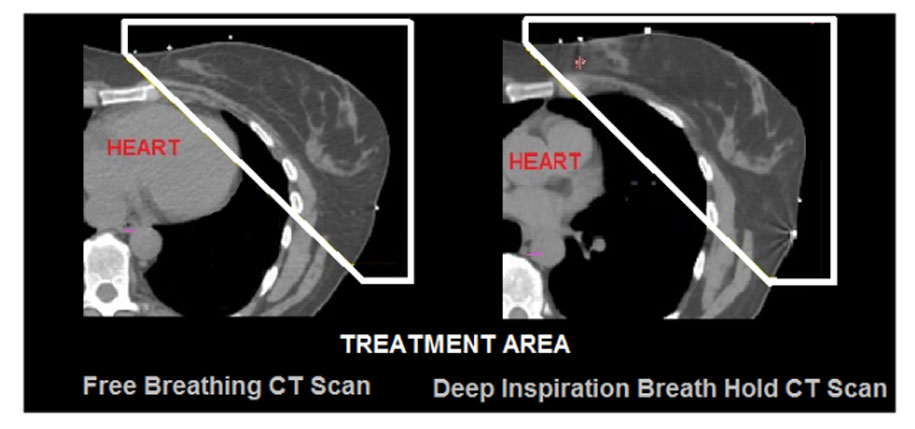
Heart moving away from treatment area as lung fills with air
WHAT IS AN ACTIVE BREATHING COORDINATOR (ABC) DEVICE?
When you breathe, the organs in your chest and abdomen (for example, your liver and heart) move. The Active Breathing Coordinator (ABC) device is used to reduce the amount your organs move by holding your breath for you. This is called a breath hold.
The ABC device has a nose clip, mouth piece, tubing and green button. You can press down on the green button when you are ready for breath hold. If for any reasons you need to stop the breath hold, you can release or to stop pressing down on the green button and the breath hold will stop.

You will be given time to breathe between breath holds.
You will use the ABC device when you are having your CT Simulation scan (a type of X-ray that takes detailed images of your body), and your radiation treatment. You may need a number of breath holds to complete your CT simulation scan and treatment.
You will have a teaching session to learn how to use the ABC device. You will practice until you are ready and as often as required. Your breathing cycle and how long you can hold your breath will be measured and recorded.
For your CT Simulation scan: after you practiced, the radiographer will install you in your treatment position and connect you to the ABC machine, then CT images will be taken during free breathing and others during breath hold. These CT images will be used to plan for your treatment.
For your radiotherapy session: you will practice again before your first session and before the following ones until you become familiar with the procedure. You may need several breath holds to complete each of your radiotherapy session.
WHAT SHOULD I DO TO HOLD BREATH WITH THE ABC DEVICE?
- You will need to bite a mouth piece connected to a tube, coupled with a spirometer (apparatus for measuring the volume of air inspired by the lungs). A nose clip will be placed on the nostrils to prevent you from breathing through your nose. You will have to keep in your hand the green button.
- The ABC monitor will be placed close to you to display your respiratory cycle (red or blue line) and the predefined lung volume level that you will have to reach for your breath hold (green line).
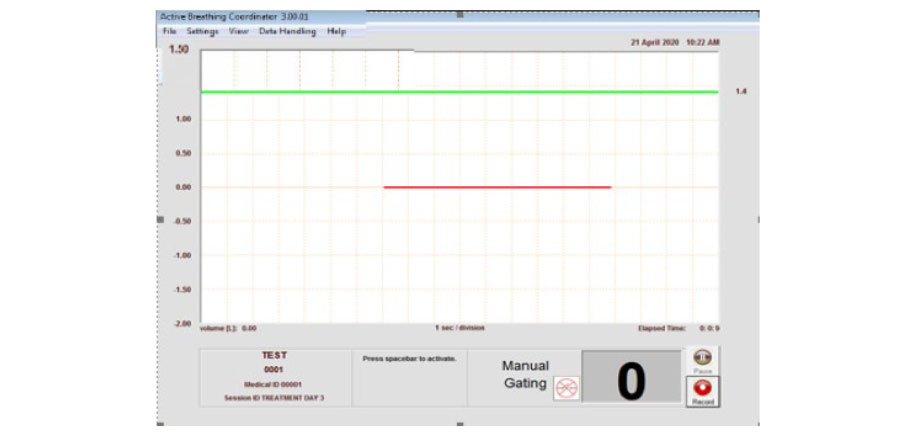
As long as you do not press the green button, the line for your respiratory cycle is red and flat
- Then, the radiographers will instruct you and guide you throughout the treatment process. They control the machine from outside the room.
Step 1: press down the green button when you are ready for the breath hold procedure.
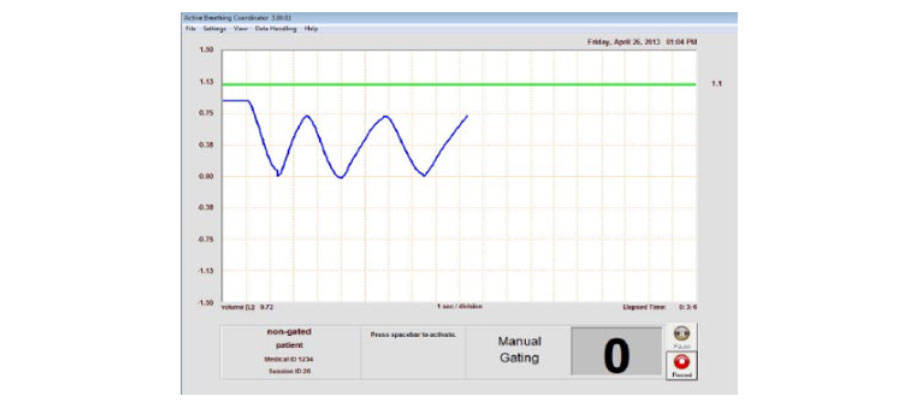
The line for your respiratory cycle is blue and waved
Step 2: reaching the expected breath hold and holding breath: you should breathe normally until the radiographer asks you to take a deep breath. When the predefined volume of air is in your lungs, the ABC system valve will close and no longer allow you to breathe in. From that time, you should hold your breath during 25 to 30 seconds, the CT images can be acquired or the radiation dose delivered.
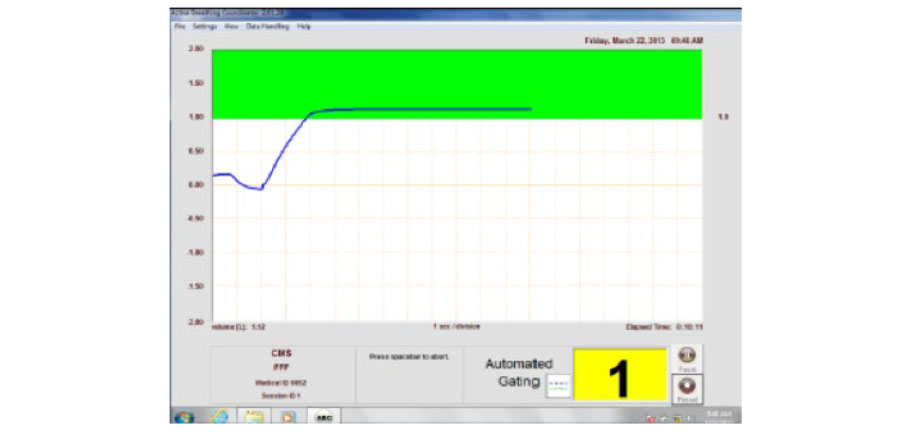
When the predefined volume of air in your lungs is reached, the blue line of your respiratory cycle is in the green area
Step 3: releasing breath hold: 5 seconds before to stop breath hold, the radiographer will countdown for you “5-4-3-2-1-breathe normally”, the valve opens again and you can breathe in normally.
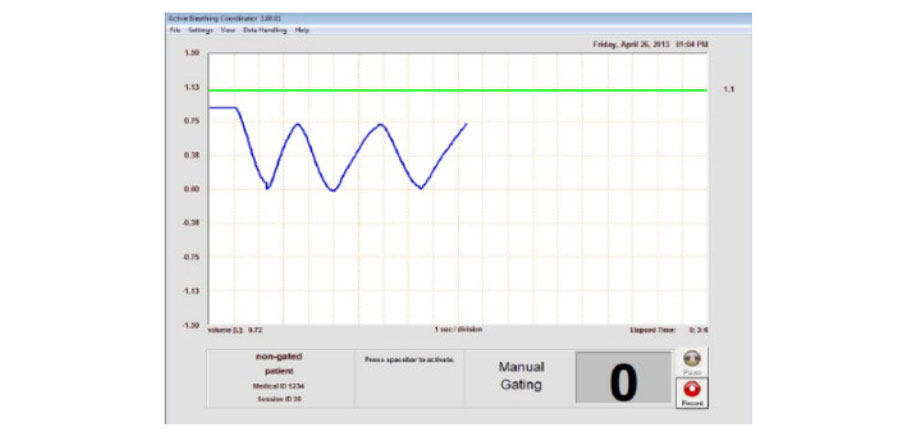
The line for your respiratory cycle is blue and waved
Step 4: repeat the breath hold to complete the procedure: the radiographer will ask you to repeat steps 2 and 3 as required. You will be given time to breathe between breath holds.
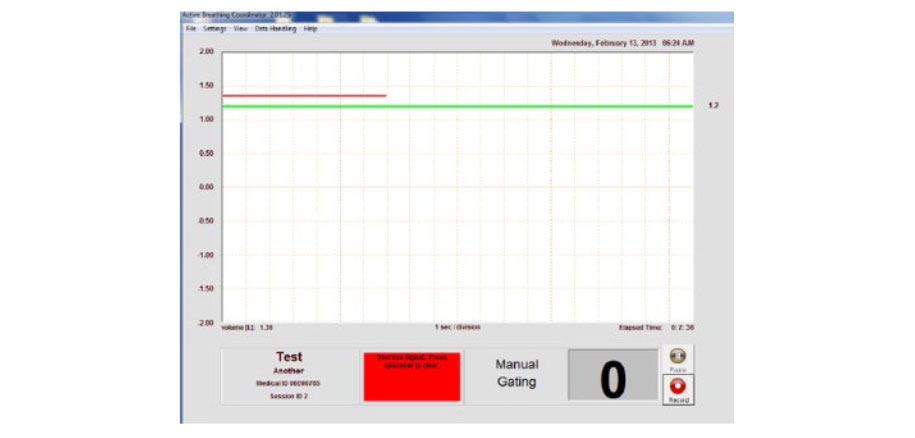
If for any reasons you need to stop the breath hold, you can press the green button 2 times in 1 second and the valve will open and allow you to breathe normally.
The screen will display a flat red line for your respiratory cycle and a red message will pop up. Upon this signal, the radiographer will make sure any radiation is stopped.
WHAT DO I NEED TO REMEMBER WHEN I USE THE ABC DEVICE FOR TREATMENT?
- Press 2 times in 1 second the green button:
- In case of emergency;
- If you can’t hold your breath anymore;
- If you feel the mouth piece or the nose clip is not sealed;
- If you need assistance from the radiographers.
- Manage your breath:
- Fill up your chest with the same amount of air from one deep breath to the other;
- Let the ABC device hold your breath;
- Take normal breaths in between breath holds.
Talk to your radiographer or oncologist if you have any question or concern.



